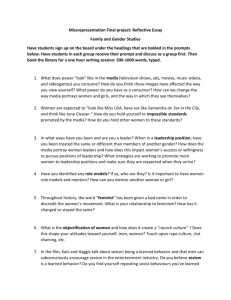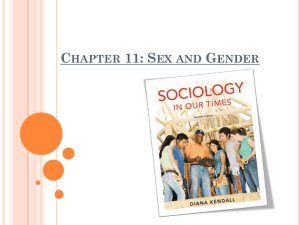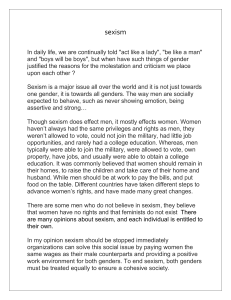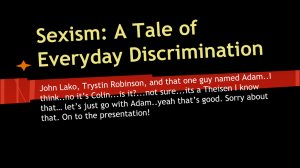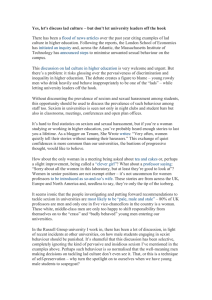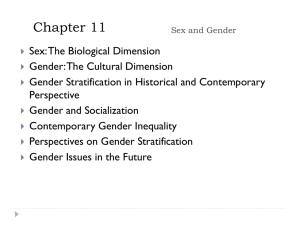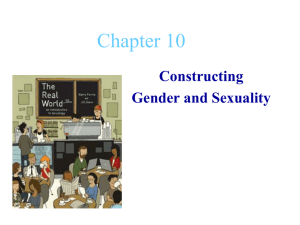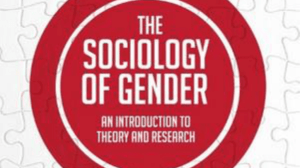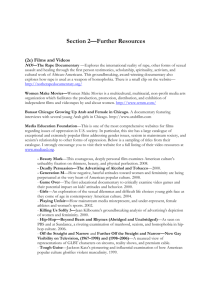Chapter 7: Gender
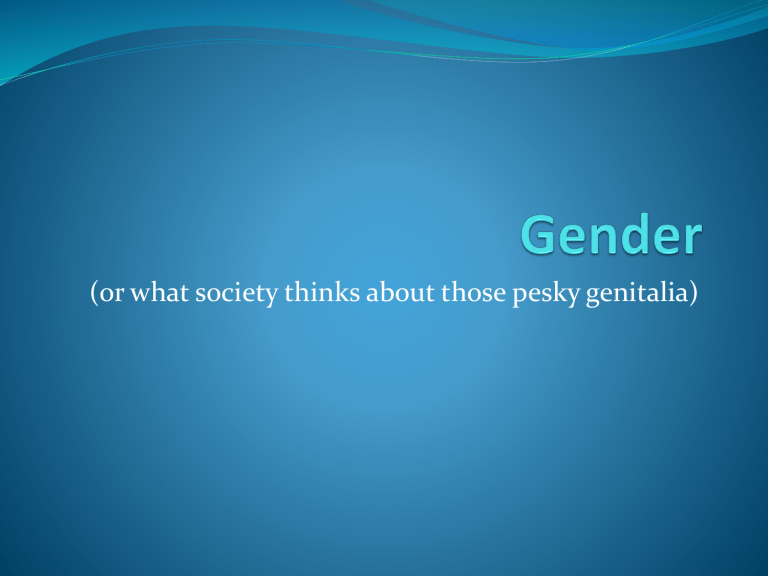
(or what society thinks about those pesky genitalia)
Gender
The social construction of gender
Sociological perspectives on gender
Sexism and sexual discrimination
Women in the U.S. workforce
Social Construction of Gender
Sex: the biological characteristics associated with men and women
Gender: the social expectations associated with masculinity and femininity
Gender roles: expectations regarding proper behavior, attitudes, and activities of males and females
We socially construct our behavior to create or exaggerate male-female differences
U.S. focuses on “masculine” and “feminine” characteristics
Gender Role Socialization
Homophobia: fear of and prejudice against homosexuality
Adults, older siblings, mass media, religious institutions, and educational institutions exert important influence
Parents are normally the first and most crucial agents of socialization
Women and men’s gender roles are c reated in part by identifying with females and males in families, neighborhoods, and in the media
Women experience a mandate to marry and become mothers
Gender Roles in the U.S.
Society defines men’s roles in terms of economic success
Brannon and Doyle: male gender role
Antifeminite element
Success element
Aggressive element
Sexual element
Self-reliant element
Increasing numbers of men in U.S. criticized restrictive aspects of traditional male gender role
Multiple masculinities: men play variety of gender roles, including a nurturing-caring role and effeminate-gay role, in addition to traditional gender role of dominating women
Cross-Cultural Perspective
Anthropologists have documented highly diverse constructions of gender that do not always conform to out own ideals of masculinity and femininity
There appear to be no innate or biologically determined gender roles for men and women
Functionalist Perspectives on
Gender
Contributes to overall social stability
Instrumentality: emphasis on tasks
Expressiveness: maintenance of harmony and internal emotional affairs of family
Dividing tasks between spouses was functional for the family as a unit
Conflict Perspectives on Gender
Functionalist approach masks underlying power relations between men and women
Relationships between females and males are traditionally one of unequal power
View gender differences as reflection of subjugation of one group (women) by another group (men)
Feminist Perspectives on Gender
Engels argued women’s subjugation coincided with rise of private property
Many contemporary theorists view subordination as part of overall exploitation and injustice inherent in capitalist societies
Matrix of domination: convergence of social forces that contribute to subordinate status of poor, nonwhite women
Intersectionality
Interactionist Perspectives on
Gender
Tend to examine gender stratification on micro level of everyday behavior
We “do gender” by reinforcing traditionally masculine and feminine actions
Clothes, expressions, the way we talk
Continuing investigation of role of gender in crosssex conversations (crosstalk)
Sexism and Sexual Discrimination
Sexism: Ideology that one sex is superior to the other
Individual acts of sexism and institutional sexism occur
Sexual Harassment: Behavior that occurs when work benefits are made contingent on sexual favors or when touching lewd comments, or the appearance of pornographic material creates a hostile environment in the workplace
Generally occurs between men and women
Sexually harassment also often happens to homosexual men and women
Women in the U.S. Workforce
Gender bias limits women’s opportunities for employment outside of home and forces them to carry disproportionate burden inside the home
Increased labor force participation
Glass ceiling
Clear gender gap in the performance of housework, although differences narrowing
Second shift: work outside the home followed by child care and housework
Triple shift:
